If you’re a recruiter or a human resources manager, you need access to the latest employee retention statistics. Knowing how the labor force behaves is essential to understanding what drives people to join or leave an organization.
To illustrate our point, consider that:
- Around 20% of new employees leave the company within their first 45 days.
- Another 31% quit their new job before the end of their sixth month.
- Most employees rethink their jobs as they approach their work anniversary. They are however 10 times more likely to make a move around their first anniversary than their fifth anniversary.
- According to the Bureau of Labor Statistics 2022 Report on employee tenure, the average employee will stay with a company for 4.1 years — a median figure which remained unchanged from the previous year.
- Breaking tenure statistics down by gender, men hold fast at 4.3 years. For women, the median tenure was 3.8 years in January 2022, down from 3.9 years in 2021. Although this is a small change in average, it does point to a trend in resignations under women, dubbed the Great Breakup.
- but seniority does affect this average. The median tenure for managers is 6.4 years.
- The 2022 Job Seeker Nation Report survey revealed that 45% of U.S. employees are searching for a new position or planning to do so in 2023.
- About 3.9 million workers quit their jobs every month in 2021 vs. roughly 4 million per month in 2022.
- Historically, the month with the highest number of resignations was November 2021, when 4.5 million quit their jobs. This is considered to be the peak of the Great Resignation, which means we expect a decrease in voluntary separations in 2023. Though you'll still likely need to write a few farewell messages to coworkers this year, too.
Armed with this and other employee retention statistics we’ll cover in this article, you can create an array of employee retention strategies. This will assist in transforming your business into a place that people would not want to leave.
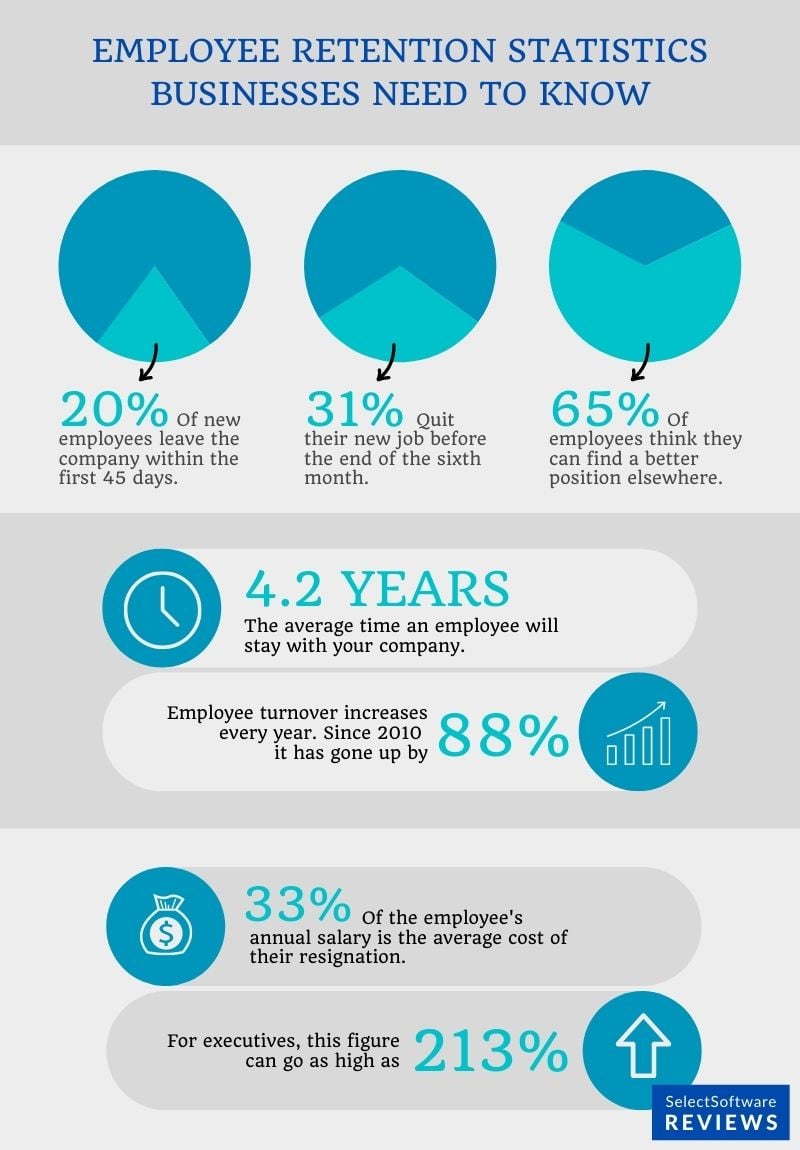
Year on Year Employee Retention Statistics
Based on a report published by the Bureau of Labor Statistics (BLS), total separations in the United States for December 2020 increased by 20% compared to December 2019. The numbers varied from state to state, but all of the regions saw a rise in total separations between 2019 and 2020. These figures saw a steady decline in 2021 and 2022.
Along with this, we saw the U.S. unemployment rate at an all-time low of 3.5% at the end of 2022. A figure that quickly rebounded from 8.1% in 2020.
The BLS defines the quits rate as the number of quits during a period as a percent of annual average employment within a given sector. The Bureau report on this both as a monthly percentage of all employment, and an annual percentage of all employment per sector and industry.
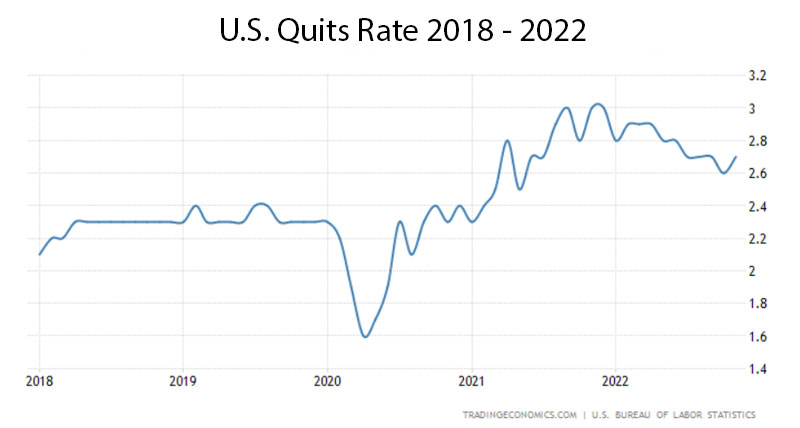
Quits are closely linked to job availability, and both the quits rate and the number of available jobs are consistent with fluctuations in the economic cycle. They tend to rise when the economy expands and go down when the economy shrinks.
One way to read the quits rates is as a gauge of how confident the employees are that they can find and secure a new job.
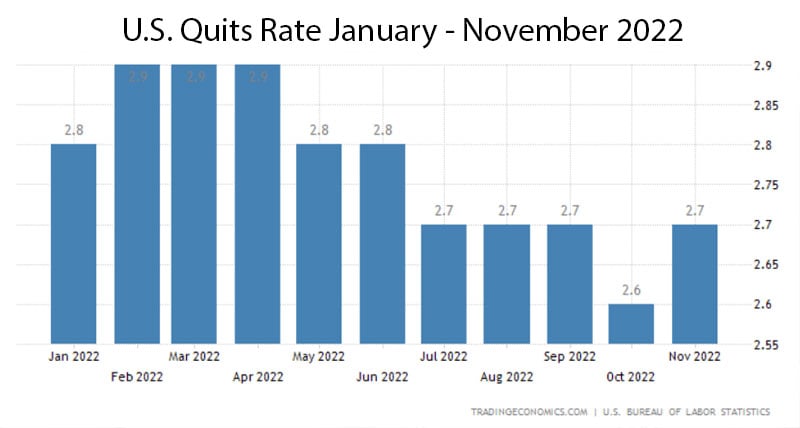
The number of job quits in the United States declined to 4.026 million in October of 2022, the lowest we’ve seen since May 2021. Although quits increased to 4.17 million in November 2022, it is still far below the 4.6 million seen a year prior.
- On a federal level, the quit rate for November 2022 was 2.7%.
- In November 2021, the height of the Great Resignation, the average quit rate was 3%, egged on by a staggering 3.4% in the private sector.
- Voluntary separations are significantly lower under government workers. Even at its highest point last year, the public sector quit rate for November 2021 was a mere 1.1%. By comparison, the quit rate for November 2022 was 1.0%.
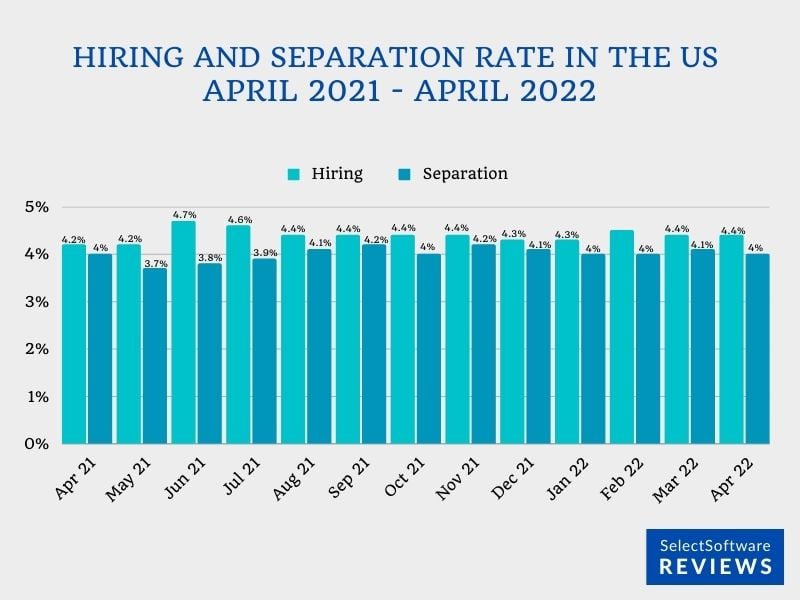
Quits are closely linked to job openings, and both quit rates and the number of available jobs are consistent with fluctuations in the economic cycle. They tend to rise when the economy expands and go down when the economy shrinks.
One way to read quit rates is as a gauge of how confident the employees are that they can find and secure a new job.
The BLS defines the annual quit rate as the number of quits during the entire year as a percent of annual average employment.
- On a federal level, the quit rate for 2019 was 28%.
- 2020 saw a significant reduction in quits - likely as a result of the pandemic and the resulting uncertainty about employment elsewhere. Still, 25.2% of workers voluntarily left their jobs.
- In 2021, the height of the great resignation, the quit rate jumped to a staggering 32.7%.
- The numbers vary from one industry to another, but private businesses had an overall quit rate of 27.9% in 2020, down from 31.1% in the previous year.
- This was a short-lived decline. Resignations in the private sector shot to 36.6% in 2021.
- Overall the public sector is doing better. The government saw a quit rate of 10.8% in 2021.
- Although this is a far lower number compared to the private sector, the percentage of government employees who leave their position is increasing each year. In 2019 public sector resignations were at 9.9%. In 2020 the figure was 10.8%.
The Highest Voluntary Separations (Quit Rates) in 2021 by Industry
- Accommodation and food services: 70.7%
- Retail trade: 50.6%
- Arts, entertainment, and recreation: 42.6%
- Professional and business services: 40.5%
- Manufacturing of non-durable goods: 33.7%
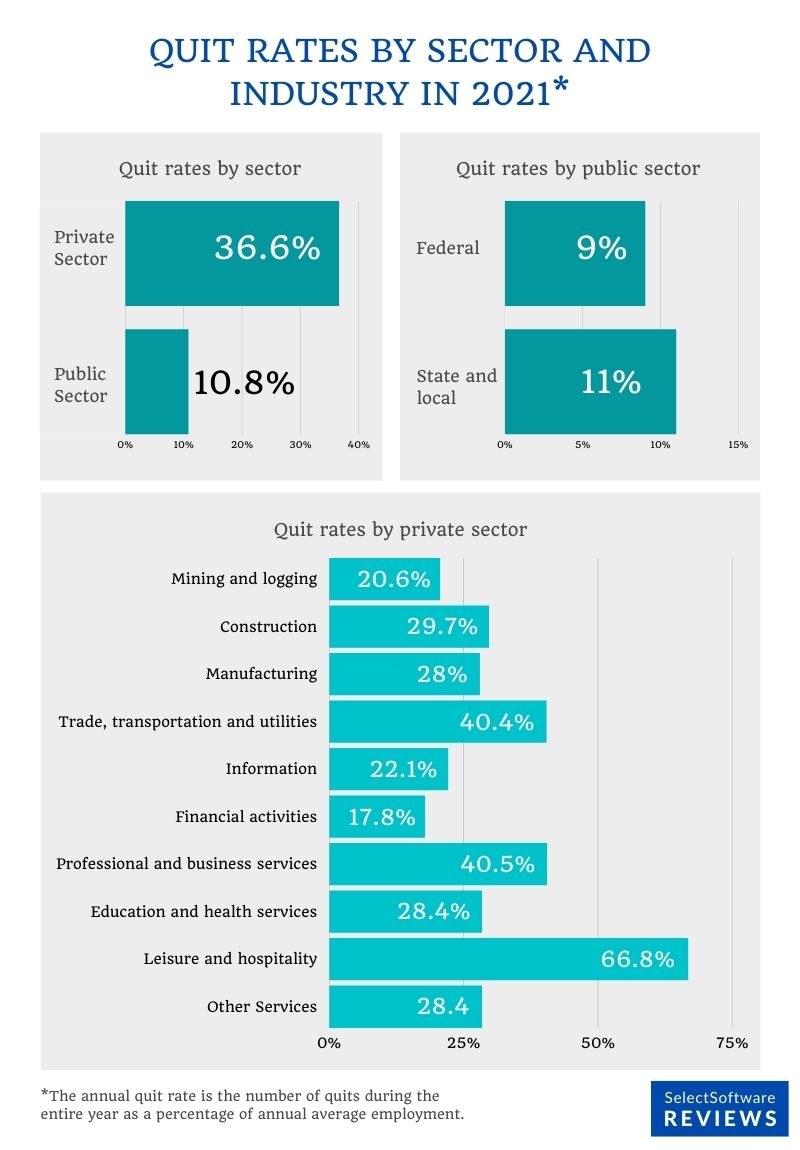
The Highest Voluntary Separations (Quit Rates) in November 2022 by Industry
- Manufacturing of Nondurable goods: 2.6%
- Manufacturing of Nondurable goods: 2.6%
- Health care and social assistance: 2.9%
- Professional and business services: 3.2%
- Arts, entertainment, and recreation: 3.4%
- Retail trade: 3.9%
- Transportation, warehousing, and utilities: 3.9%
- Accommodation and food services: 5.7%
Post-pandemic employers still see higher demand for remote work. It is realistic to expect that employer flexibility in this regard will affect the employee turnover rate.
According to Business Insider, over 90% of those who have switched jobs during the pandemic felt very strongly that life is too short for anyone to stay in a job that does not make them feel excited or even engaged. In other words, the global health crisis made people re-evaluate their relationship with work.
When the virus initially hit, a large segment of separations consisted of people who voluntarily quit because they were afraid of getting exposed. Others wanted to stay home to take care of their families. However, now that the restrictions and fear have subsided, workers are still resigning in search for one or several of the following:
- More work flexibility
- Higher pay
- Better benefits
- More robust safety measures
- A clearer career path
- Work that aligns with their personal values
- Recognition
- A healthier work-life balance
That being said, the employees who resign may have stayed put if their companies offered work-life balance, minimized employee burnout, and provided a better overall employee experience. A major factor in how we perceive job viability post-pandemic is in terms of flexibility. Knowledge workers no longer accept a reality where they spend hours in traffic to execute digital tasks that could have been done from anywhere.
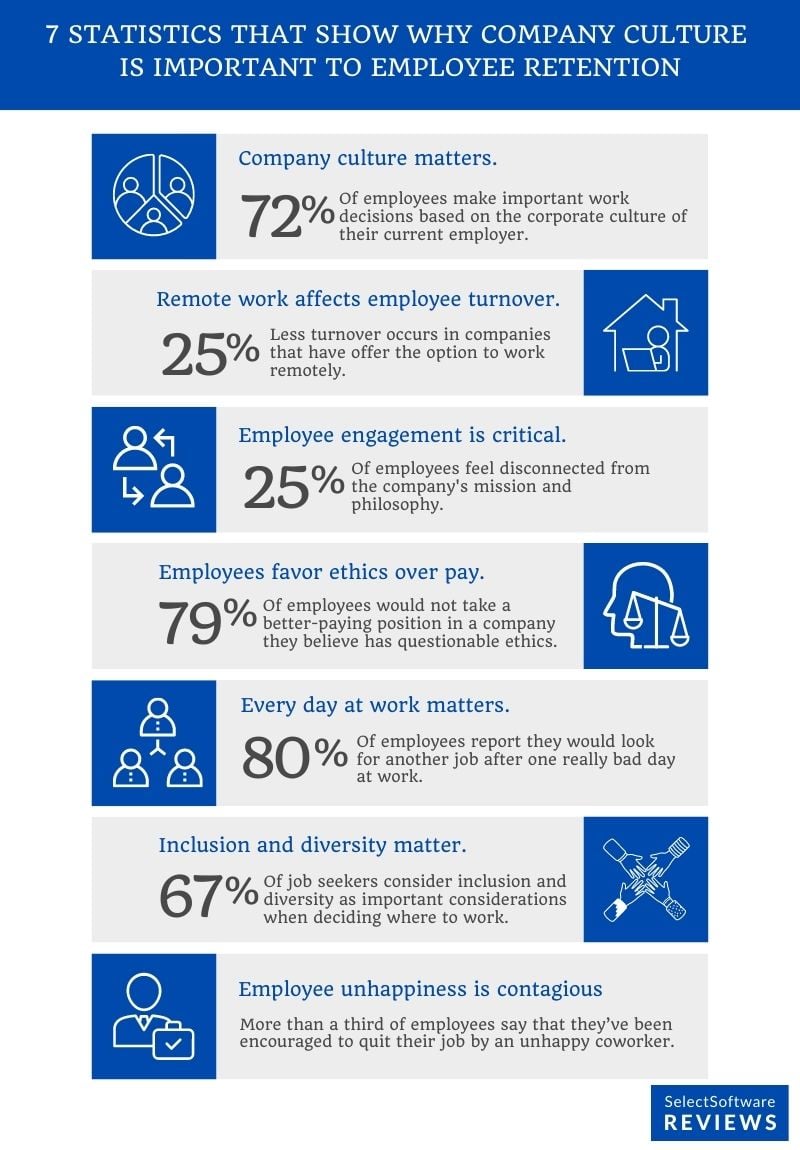
Work from Home Statistics in 2023
A Future Forum Pulse Report published in 2022 revealed that workers with full flexibility (to work any time from anywhere) report 29% higher productivity and 53% greater ability to focus than workers with no control over their schedule.
Remote work allows workers to keep their jobs and still be productive without leaving the comfort or safety of their own homes. During the height of the pandemic, remote work helped businesses stay afloat in the face of city-wide lockdowns and quarantine protocols.
Contrary to fears of lost productivity, remote work has proven to be a viable business model.
Remote work statistics
- In a survey run by FlexJobs, 58% workers reported that they want a fully remote job and 39% said they prefer a hybrid work arrangement.
- A mere 3% of workers want to return to in-office on a full-time basis.
- Remote work during COVID improved productivity by 5%.
- In a University of Chicago research paper, nearly six in ten of survey respondents reported higher productivity when working remotely, while only 14% reported being less productive.
- According to the study, remote work productivity was over 7% higher than in-office productivity.
- The major benefit is doing away with a commute. On average workers spend 35% of the time they save by working from home on being more productive.
- Research from Owl Labs found that remote and hybrid employees are also 22% happier than workers in an onsite office environment.
- Retention benefits from remote work. 48% of the survey participants said that, if they were no longer able to work remotely, they would start looking for another job that offered more flexibility.
- Despite these clear benefits, 44% of companies don’t allow remote work.
In this emerging paradigm, it is important for HR leaders, who are in charge of acquiring and keeping the organization’s top talent, to keep track of key employee retention metrics. Doing so will enable them to increase job satisfaction and help employees stay.

Why is employee retention important?
Every time an employee leaves, the company incurs losses, which hurts its bottom line. Remember that every organization invests time and money during the onboarding of its new hires, and all of these efforts would go to waste if they end up quitting.
It is estimated that, by 2030, the average cost of low employee retention will be around $430 billion annually. This reason alone should motivate businesses to be more proactive about optimizing various development opportunities for their workforce, but there’s more to benefit from reducing the number of employees who leave.
Higher Retention Decreases the Cost of Employee Training
Aside from the cost of onboarding, companies invest in ongoing training, management oversight, and other similar activities. The less you need to train up new hires, the less you can spend on onboarding and basic training. A great benefit is that, if less budget is spent on training, more resources can be allocated to upskilling and developing your top talent.
Employee Retention Enhances Company Culture
The longer an employee stays with a company, the more they adopt its core values. This strengthens the company culture, which has a positive impact on the perceptions, preferences, and behaviors of the rest of the organization.
With a favorable work environment, new employees are more likely to stay and current employees are more likely to give their best. According to 1Huddle, around 75% of all employees make important work decisions based on the corporate culture of their current employer. Furthermore, 70% of job seekers cited corporate culture as an important factor influencing their decision to accept an offer from any given company.
Retention Leads to an Improved Applicant Pool
Top talent will likely look into your company before applying to work there. Seeing positive employee reviews on sites such as Glassdoor, as well as employees who have stuck around and been promoted on LinkedIn will affect their decision to submit their resumes.
Making retention a part of your business strategy, therefore, means you can hold on to high-performing talent, and draw the best applicants for future hires.
Retention Creates Higher Morale
If one employee after another leaves your doors permanently, it affects the ones left behind. Employees who you have managed to retain must pick up the slack as you scramble to fill positions.
As a result, there is a good chance that your remaining workforce would have lower morale, which could affect their performance. Bear in mind that, even before an employee leaves, talks of quitting and looking for other job opportunities are already affecting the mind-frame of those who stay behind.
Efforts to improve retention have the knock-on effect that, the fewer people leave, the fewer people will seriously consider leaving.

Higher Productivity
The longer you retain the services of your employees, the more experience they accumulate and the better they become at their jobs. Employee retention, therefore, makes your workforce more effective and valuable to your organization.
Aside from their individual skills, a longer tenure per employee will help their performance as a group improve. The more time different team members spend with each other, the better they can intuitively leverage one another’s strengths. Unfortunately, you stand to lose this level of productivity if even one or two of your employees exit the company.
Employee productivity statistics suggest it may take up to two years for a new employee to reach the productivity level of an existing employee.
Improved Employee Experience
Much like you would think of customer experience, employee experience describes how an employee perceives all the interactions that they’ve had in the company from the day they submitted their application, up to the day that they stop working there.
A favorable employee experience inspires loyalty and higher employee engagement. A happy, inspired workforce is more productive. The same actions you take to improve retention also boost the general morale of workers. That is why you benefit from creating a positive work environment to drive employee retention.

Less Recruiting and More Development for HR
It is important to establish continuity when it comes to business processes, especially in the HR department. Besides the implementation of employee retention efforts, and the improvement of employee experience, HR is tasked with skills development to ensure each employee has a career growth trajectory.
Losing employees can be disruptive to this operation. The more you’re replacing employees who resign, the more you’ll divert HR's time and energy towards posting job openings, sorting through resumes, interviewing applicants, and onboarding new hires. These are hours and resources that are better spent on keeping a good employee in the organization.
What is the Average Employee Retention Rate in the US?
According to Apollo Technical, good companies retain an average of 90% of their employees. This translates to an employee turnover rate of 10% or less if you don’t factor in dismissals and retirements.
According to data from November 2022, the government has the lowest quits rate among all the sectors (1.0%), followed by:
- Educational services: 1.3%
- Finance and insurance: 1.4%
- Information: 1.5%
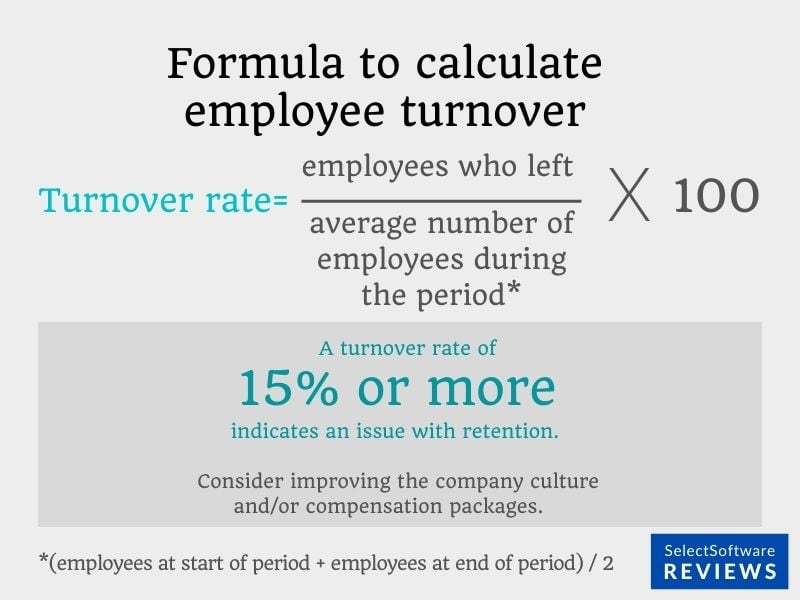
What Is a Healthy Employee Turnover vs Retention Rate?
Turnover rate is often used interchangeably with retention rate, which is understandable because they are two different sides of the same coin.
An organization’s turnover rate describes the rate at which full-time employees leave, while the company's employee retention rate is an indication of how many employees choose to stay for a given time period.
However, employee turnover should not be confused with attrition, where an employee leaves through a natural process like resignation or early retirement due to a health problem.
To compute the turnover rate, get the average number of employees by adding the number at the start of a given time period to the number at the end. Divide this figure by two. Next, get the total number of employees who left within the same period (excluding involuntary turnover), divide it by the average number of employees you got previously, and multiply your result by 100.
Again, the actual numbers vary from industry to industry, but generally, an annual turnover rate of 10% can be considered healthy.

What Is a Bad Turnover Rate?
Employee turnover is more than just a number to watch. The reasons why employees leave are also important.
When a good employee leaves for a higher position in a different company, it shows your company has a robust training program and a clear professional development plan, allowing employees to learn new skills and become attractive to other employers. This can be a good selling point when you start recruiting to fill the position.
However, if someone leaves a company to assume the same position in another company, you need to take a close look at your employee retention efforts. This scenario indicates that something is amiss, compelling the employee to go through the trouble of pursuing other job opportunities for potentially the same compensation.
According to Business.com, if your organization has a bad employee turnover rate, one of more than 15% calculated on annual turnover, you should sound the alarm bells. The most logical action would be to improve your company culture and/or compensation package.
Industries with the Highest Employee Turnover Rates
Employee turnover rates in the US vary from one industry to another, but in general, private companies have higher quit rates compared to government offices. This is based on figures released by the Bureau of Labor Statistics.
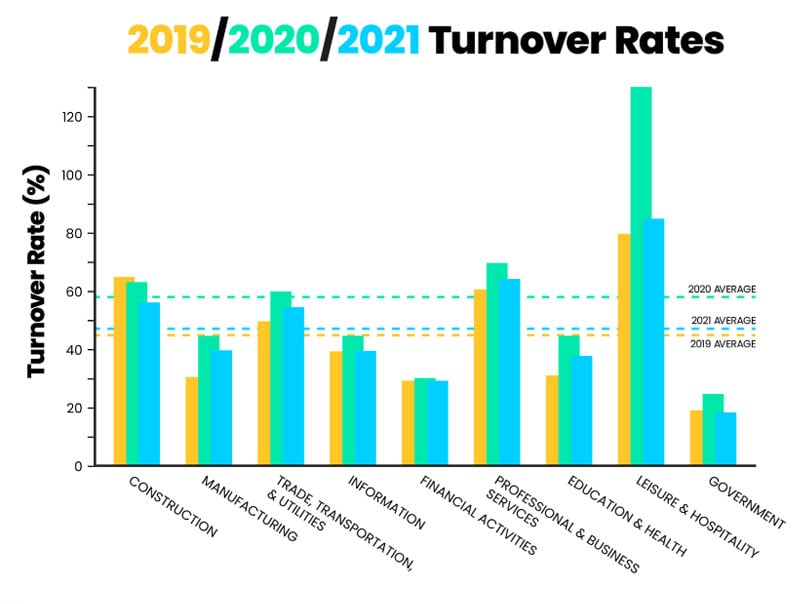
A report by Awardco compares turnover rates of notoriously low-retention industries from 2019, 2020, and 2021. Bear in mind, their finding count every employee who left a company during these years, including retiring, firing, and discharges.
According to their findings, the highest turnover rates in 2021 were seen in
- Leisure and Hospitality: 84.9%
- Professional and Business services: 64.2%
- Construction: 56.9%
- Trade, Transportation, and Utilities: 54.5%

While it is important to know what industries have the highest turnover rates, knowing the reason behind the quits is equally crucial.
For instance, in the tech industry, the high turnover rate for some of the professions might be due to high demand. More recently, we’ve also seen major reductions in force (layoffs) in the technology sector. Tech, being so web-based, is also one of the industries under the most pressure to offer a remote work policy.
On the flip side, there are volatile industries where the pay is low, the hours are long, and layoffs are rampant - retail, for example.
In other words, the high turnover rate can be an indication that the industry is either very healthy or not. Whatever business you are in, it is beneficial to know your sector’s average turnover rate so you know where you stand, especially in relation to your competitors.
Industries with the Lowest Employee Turnover Rates
In the US, the government has an overall annual quits rate of about 10%, which is very low compared to the private sector. The lowest is employment at the federal level, which piqued at 9% in 2021. State and local posts have a quit rate of 11%, but if you exclude the education sector, it goes up to 12.2%.
In the private sector, companies involved in various financial activities have one of the lowest employee turnover rates, which is at 17.8% on average. Here’s a breakdown of the financial sector:
- Finance and insurance: 16%
- Real estate, rental, and leasing: 23.1%
Other top performers in terms of low employee turnover are educational services (17.1%) and information services (22.1%).

Statistics on the Cost of Employee Turnover
Losing an employee can affect a company in many ways, and there are many factors that determine the total cost of the turnover. Generally, it can be broken down into four major components:
- The initial cost to terminate the employment (including impact on company culture and employee morale)
- The cost of recruitment, hiring, and onboarding
- The lost income opportunity while the position remains unfilled
- The loss of productivity as the new hire goes through a learning curve
According to GrowthForce, the total cost that comes with losing an employee could range anywhere from half the lost employee’s annual salary, and up to 3 times as much for a middle manager. So if, for example, a supervisor who earns $60,000 a year quits, you might expect your company to lose a total of $180,000.
Gallup estimates the cost cap at around 200% of the employee’s annual salary.
The Work Institute has a more conservative estimate for the cost of employee turnover. In their 2020 Retention Report, they recommend a turnover cost of 30% of the employee’s yearly income. Using the same example above, losing an employee that earns $60,000 a year would cost your company $18,000. In the same report, the Work Institute states that around 42 million workers left their jobs in 2019 in the US alone. By their calculator, this amounted to a total cost of $630 billion.
Employee Benefit News or EBN has a similar assumption. They estimate the cost at 33% of the employee’s annual salary.
The cost that applies to your company depends on various factors. For example:
- The responsibilities and seniority of the employee that resigned
- Whether or not their workload is on hold while you replace them
- The efficiency of your recruiting ops
- The cost of outsourced and internal recruiting tasks
- The applicant pool you can pull from
- How much training the new hire needs
- How soon the new hire can be onboarded to function at full capacity
Regardless of the situation, you stand to lose a hefty sum every time an employee quits. However, beyond simply calculating the cost of retention, it is important to realize that a company’s workforce is an appreciating asset whose economic value increases over time.
If you weigh the cost of onboarding and training an employee on an ongoing basis, there comes the point where the company transitions from investing to benefitting from the employee. So if a worker who is already adding more value to the company quits, it would have a more significant impact.

Statistics on the Why Employees Leave Their Job
According to a 2021 report released by the Society for Human Resource Management (SHRM), over 40% of American workers surveyed were actively seeking a new job, or were planning to do so soon. This is not exclusive to the US though. According to a Microsoft study of 30,000 workers around the world, 41% of employees are thinking of quitting this year.
If you want to manage your organization’s employee turnover rates, you must first understand what compels them to leave in the first place. Knowing the reasons behind the low employee satisfaction will allow you to come up with the most appropriate solutions.
A 2020 study by Work Institute found that 75% of employee turnover could have been prevented if the company had a better understanding of what their employees wanted.
The most commonly found avoidable causes for resignations were:
- Career-related (18%): Lack of opportunities for growth, achievement, and security
- Work-life Balance (10.5%): A need for scheduling, travel, and remote work flexibility
- Job-related (10%): Enjoyment and ownership in manageable work
- Manager-related (7.8%): Unhappiness with productive and senior relationships
- Environment (7.7%): Physical and cultural surroundings
- Rewards (7%): Compensation and benefits that were promised and/or received
According to Deloitte’s Talent 2020 report, 42% of employees seeking a new job didn’t feel that their company failed to maximize their abilities and skills.
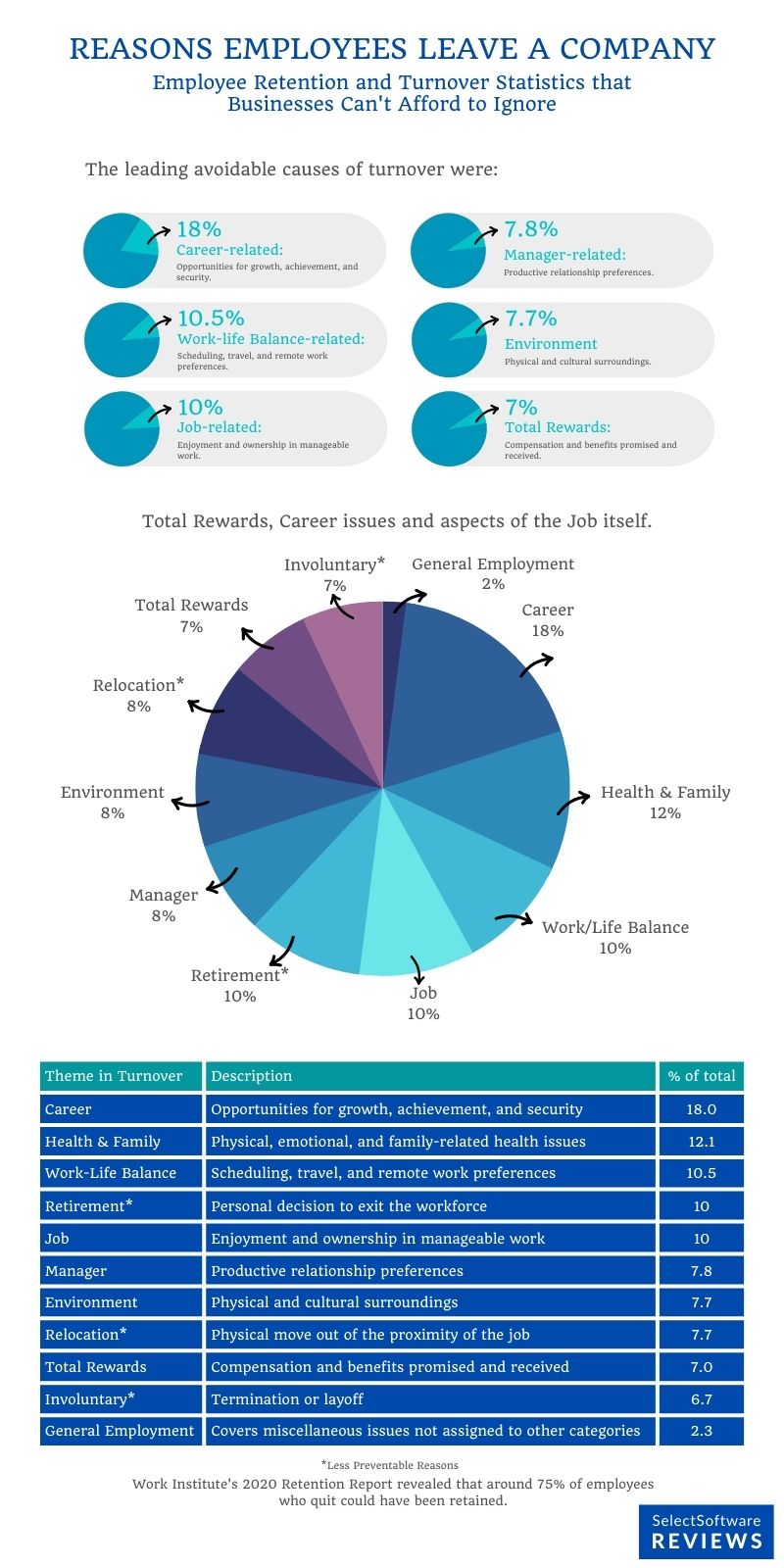
Reduced Employee Satisfaction Due to Lack of Work-Life Balance
HubSpot Blog surveyed 500 marketing professionals to gain a better understanding of the high turnover rates in some companies. They found that four out of every ten employees quit their jobs to pursue a better work-life balance.
Around the same number of workers (37%) wanted a more flexible work schedule.
Here are some of the other reasons why people are looking for greener career pastures:
- Lack of remote work options: 30.8%
- Switching career paths or pursuing other passions: 29.9%
- Lack of career growth opportunities: 27.4%
- Burnout: 20%
Remote work is a major part of work-life balance. EY’s global 2021 Work Reimagined Employee Survey surveyed over 16,000 employees across 16 countries and from multiple industries and roles. The study found that 54% of employees would consider quitting their job if they weren’t offered flexibility in where and when they work.
In the same EY study, 90% of respondents said they want flexibility in both their working location and working hours. If they had to choose between the two, 54% prefer determining their own hours and 40% choose flexibility in location.
Fully remote is not necessarily a requirement though. The EY survey also found that, on average, employees want to work remotely 2-3 days per week.
Statistics on How to Retain Employee
Now that we understand why employees become restless in their jobs to the point of quitting, let’s discuss how you can increase employee retention in your company.
Create a Remote Work or Hybrid Policy
First, allow your employees to work remotely where it is possible or feasible. You could also explore the possibility of implementing a hybrid workplace where they can report at the office some days and work from home on others.
Based on the statistics in the previous section, investing in a remote or hybrid setup will increase employee satisfaction by 40%. In addition, LegalJobs believes that companies offering remote work as an option to their employees lower their turnover rate by 25%.
Make Their Onboarding Experience a Priority
According to Work Institute’s 2020 Retention Report, approximately 40% of employee turnover occurs within the employee’s first year with an organization. Other research found that, at companies with engaging onboarding processes, retention throughout the first year of employment is 91%.
The discrepancy is easy to understand. A meager 12% of workers think their employer does a great job with onboarding new hires.
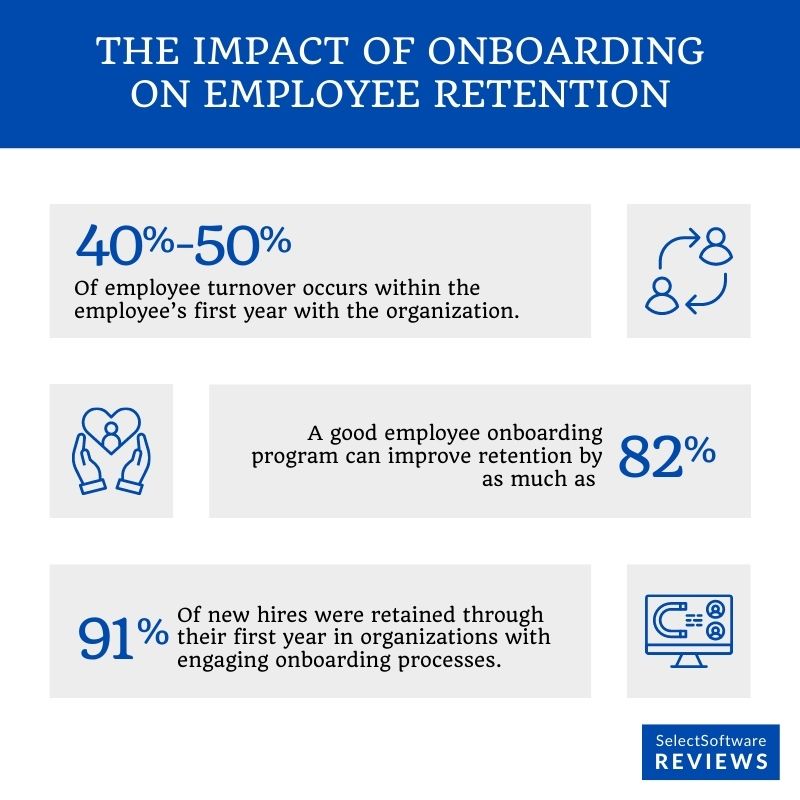
If you don’t make a good first impression and engage team members early on, your high-performing new hires are likely to be concerned and start looking for their next move. Get more insight into effective onboarding practices in our Ultimate 7-step Guide.
Improve Employee Engagement
According to Gallup, “Employees who are engaged are more likely to stay with their organization, reducing overall turnover and the costs associated with it. They feel a stronger bond to their organization’s mission and purpose, making them more effective brand ambassadors. They build stronger relationships with customers, helping their company increase sales and profitability.”
In Gallup's latest Global 2022 State of the Workplace report, they note that an astounding 81% of workers claim they are disengaged or “checked-out” at work. In its 2020 Meta-analysis report, Gallup also found that teams with low engagement levels see employee turnover rates 18% to 43% higher than teams with high engagement levels.
Employees who feel that they belong and are valued within your organization are less likely to leave. If you want to increase employee retention, encourage a strong connection among them using various employee engagement tools. Based on research conducted by Qualtrics XM, nine out of every ten workers who feel a sense of belonging are highly engaged with their work.
For more insight in ow to improve employee engagement, read our article on How to Keep Remote Employees Engaged
Prioritize the Well-being of Your Employees
Employee wellness programs that focus on health and fitness can relieve employee stress through physical activity or by providing information on health and proper nutrition.
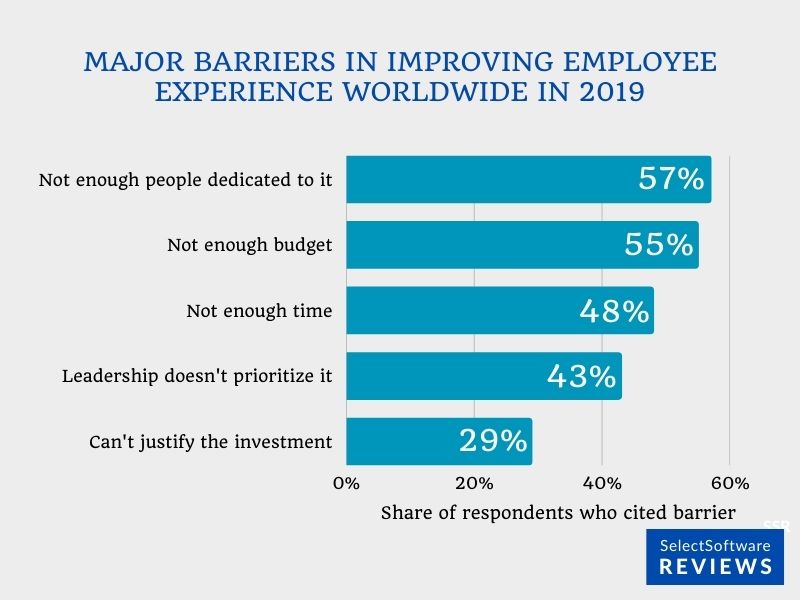
This is not the only wellness you can address though. Also, provide them with different employee financial wellness platforms and employee assistance programs focused on supporting their mental health.
Recognize and Reward Good Work
Of course, you need to provide employee recognition to any good employee who deserves it. Using a dedicated employee rewards platform to maximize engagement can be a great investment.

Fueling Business Success Through Employee Retention
Research by Gallup discovered that 52% of employees who resigned from their job admitted that their manager or company could have changed their mind about leaving if they tried.
However, 51% of the exiting employees surveyed reported that, in the three months leading up to their departure, neither their manager nor other leadership members discussed their job satisfaction or future with the company with them. What we can learn from this is that the answer to retaining employees is simple: Communicate with them.
The success of a business is closely tied to the success of its people, as one could not survive without the other. To make this happen, keep an eye out for key employee retention statistics at all times, see how you can overcome obstacles to employee happiness, and listen to your workforce.














